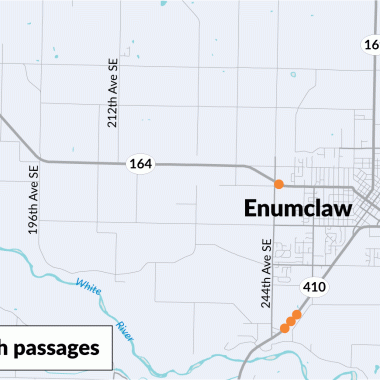At SR 164, two culverts will be replaced west of Enumclaw along Seconds Creek and an Unnamed Tributary to Newaukum Creek.
- Seconds Creek flows through a four-foot diameter concrete culvert and is not passable for fish because the culvert is too high, preventing fish from traveling upstream and causing juvenile fish to fall from the culvert. Removing this barrier will open nearly one mile of habitat for Coho salmon and steelhead, cutthroat trout and resident trout.
- Unnamed Tributary to Newaukum Creek flows through a four-foot diameter concrete culvert that is not passable for fish because the water flows from the culvert onto rocks at a location where fish need a staging pool. The new fish-passable structure will open nearly 1.5 miles of habitat for Coho and chum salmon and sea-run cutthroat, steelhead and resident trout.
At SR 410, three culverts will be removed south of Enumclaw along an Unnamed Tributary to Boise Creek. The creek follows an s-shape under the highway, flowing from the north side of SR 410 to the south side and back. We will re-channelize the creek to cross the highway only once at the southernmost culvert.
- The northernmost culvert flows under SR 410 through a 2.5-foot diameter concrete culvert and is not passable for fish because of the depth of water. Removal of this fish barrier will open nearly one-half mile of habitat for Coho salmon and steelhead, sea-run cutthroat trout and resident trout.
- The middle culvert flows under SR 410 through a three-foot diameter concrete culvert and, while technically passable, this culvert will be removed because a new open channel will be constructed on the north side of the highway.
- The southern culvert flows through a four-foot diameter concrete culvert under SR 410 and is not passable for fish because the swim up the culvert is too steep. The new fish-passable structure will open .7 miles of habitat for Coho and pink salmon and steelhead, sea-run cutthroat trout and resident trout.
When replacing fish barriers, we must build structures and improve the stream so that fish can use it year-round at all stages of their life. That means during summer months when streams are usually lower, the stream must be usable by juveniles and adults. During winter, when water tends to run higher and faster, the stream must also have areas where fish can rest.
New fish passable structure
To replace the five existing culverts, WSDOT will build four new fish-passable structures and eliminate one culvert. We'll also add woody vegetation, logs and other wood to these streams to provide channel complexity and diversity, such as pools that provide refuge for young fish. These habitat elements enhance rearing and spawning habitat for fish. The improvements mean fish will have access to nearly three miles of habitat that was previously inaccessible.
This work is part of our fish passage program. Replacing the existing culverts and rebuilding the stream channels expands healthy fish habitat; an important step in restoring fish runs and increasing populations. This benefits commercial seafood operations and recreational fishers and provides more food for a declining orca population. Additionally, replacing these fish barriers helps us meet our obligation to remove barriers under the 2013 U.S. District Court injunction.
SR 164 projects
$16.93 million from Pre-Existing Funds (PEF), the Connecting Washington Account (CWA), Move Ahead Washington (MAW) and the State Motor Vehicle Account (MVA).
SR 410 projects
$18.31 million from Pre-Existing Funds (PEF), the Connecting Washington Account (CWA), Move Ahead Washington (MAW) and the State Motor Vehicle Account (MVA).
Seconds Creek’s existing four-foot diameter culvert crosses SR 164 and poses a barrier to fish passage.
The Unnamed Tributary to Newaukum Creek culvert crosses under SR 164 and is not passable for fish.
The northern Unnamed Tributary to Boise Creek culvert crosses under SR 410 and is not passable for fish.
The existing southern Unnamed Tributary to Boise Creek culvert crosses under SR 410 and is not passable for fish.

